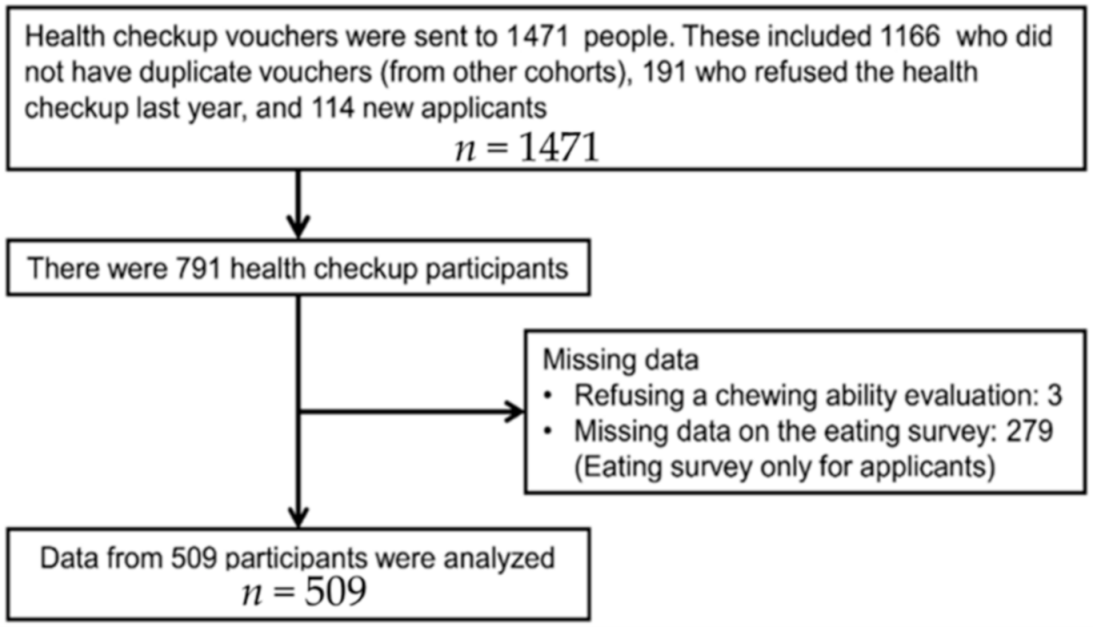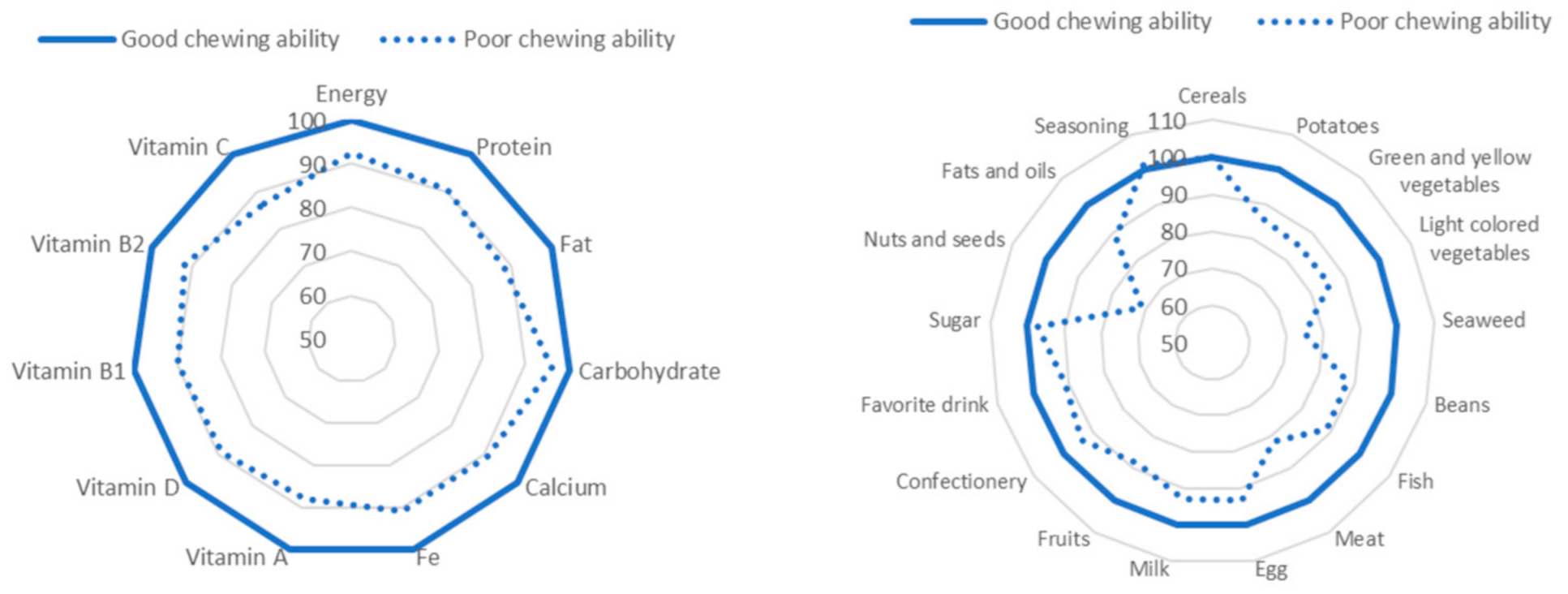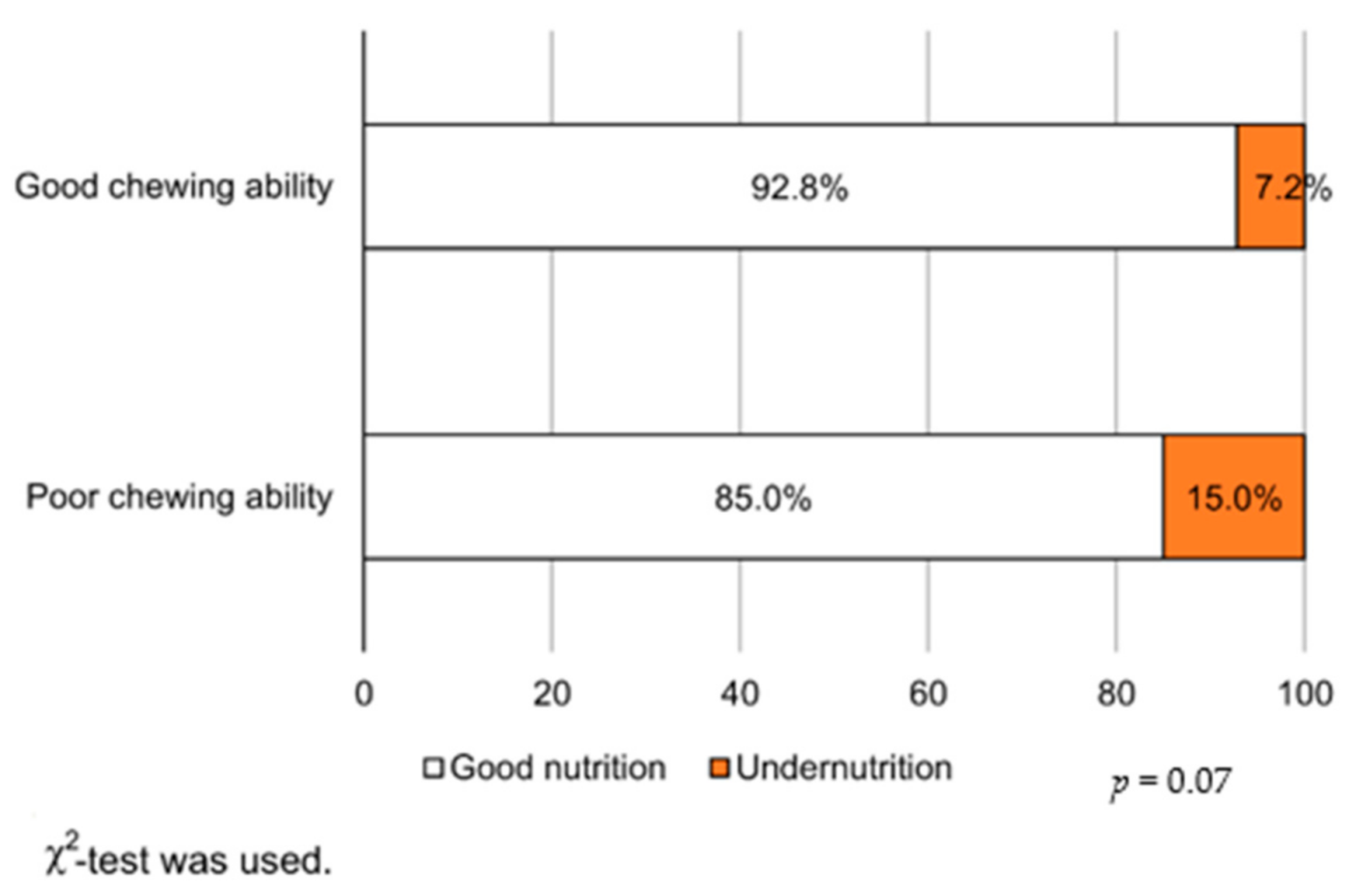Relationship between Chewing Ability and Nutritional Status in Japanese Older Adults: A Cross-Sectional Study
Abstract
1. Introduction
2. Materials and Methods
2.1. Participants
2.2. Survey Items
2.2.1. Basic Information
2.2.2. Evaluation of Chewing Ability
2.2.3. Body Measurements
2.2.4. Undernutrition Diagnosis
2.3. Eating Survey
2.4. Statistical Analysis
2.5. Ethical Considerations
3. Results
4. Discussion
5. Conclusions
Supplementary Materials
Author Contributions
Funding
Institutional Review Board Statement
Informed Consent Statement
Data Availability Statement
Conflicts of Interest
References
- Cabinet Office. Annual Report on the Aging Society Japanese 2015. Government of Japan, 2015. Available online: https://www8.cao.go.jp/kourei/whitepaper/w-2015/gaiyou/27pdf_indexg.html (accessed on 25 April 2019).
- Ministry of Health, Labor and Welfare. Health Japan 21 (the Second Term). Government of Japan, 2012. Available online: https://www.mhlw.go.jp/bunya/kenkou/dl/kenkounippon21_01.pdf (accessed on 25 April 2019).
- Landi, F.; Zuccala, G.; Gambassi, G.; Incalzi, R.A.; Manigrasso, L.; Pagano, F.; Carbonin, P.; Bernabei, R. Body mass index and mortality among older people living in the community. J. Am. Geriatr. Soc. 1999, 47, 1072–1076. [Google Scholar] [CrossRef]
- Antonelli Incalzi, R.; Landi, F.; Cipriani, L.; Bruno, E.; Pagano, F.; Gemma, A.; Capparella, O.; Carbonin, P.U. Nutritional assessment: A primary component of multidimensional geriatric assessment in the acute care setting. J. Am. Geriatr. Soc. 1996, 44, 166–174. [Google Scholar] [CrossRef]
- Incalzi, R.A.; Gemma, A.; Capparella, O.; Cipriani, L.; Landi, F.; Carbonin, P. Energy intake and in-hospital starvation: A clinically relevant relationship. Arch. Intern. Med. 1996, 156, 425–429. [Google Scholar] [CrossRef]
- Tanaka, T.; Takahashi, K.; Hirano, H.; Kikutani, T.; Watanabe, Y.; Ohara, Y.; Furuya, H.; Tetsuo, T.; Akishita, M.; Iijima, K. Oral frailty as a risk factor for physical frailty and mortality in community-dwelling elderly. J. Gerontol. Ser. A Biol. Sci. Med. Sci. 2018, 73, 1661–1667. [Google Scholar] [CrossRef] [PubMed]
- Tanimoto, Y.; Watanabe, M.; Sugiura, Y.; Hayashida, I.; Kusabiraki, T.; Kono, K. Factors related to sarcopenia in community-dwelling elderly subjects in Japan. Nihon Koshu Eisei Zasshi 2013, 60, 683–690. [Google Scholar] [PubMed]
- Krall, E.; Hayes, C.; Garcia, R. How dentition status and masticatory function affect nutrient intake. J. Am. Dent. Assoc. 1998, 129, 1261–1269. [Google Scholar] [CrossRef] [PubMed]
- Minakuchi, S.; Tsuga, K.; Ikebe, K.; Ueda, T.; Tamura, F.; Nagao, K.; Furuya, J.; Matsuo, K.; Yamamoto, K.; Kanazawa, M.; et al. Deterioration of Oral Function in the Elderly The Position Paper from Japanese Society of Gerodontology in 2016. Jpn. J. Gerodontol. 2016, 32, 81–99. [Google Scholar]
- Iwasaki, M.; Yoshihara, A.; Ogawa, H.; Sato, M.; Muramatsu, K.; Watanabe, R.; Ansai, T.; Miyazaki, H. Longitudinal association of dentition status with dietary intake in Japanese adults aged 75 to 80 years. J. Oral Rehabil. 2016, 43, 737–744. [Google Scholar] [CrossRef] [PubMed]
- Zhu, Y.; Hollis, J.H. Associations between the number of natural teeth and metabolic syndrome in adults. J. Clin. Periodontol. 2015, 42, 113–120. [Google Scholar] [CrossRef]
- Koyano, W.; Hashimoto, M.; Fukawa, T.; Shibata, H.; Gunji, A. Functional capacity of the elderly: Measurement by the TMIG Index of Competence. Nihon Koshu Eisei Zasshi 1993, 40, 468–474. [Google Scholar]
- Folstein, M.F.; Folstein, S.E.; McHugh, P.R. “Mini-mental state”. A practical method for grading the cognitive state of patients for the clinician. J. Psychiatr. Res. 1975, 12, 189–198. [Google Scholar] [CrossRef]
- Kamiyama, M.; Kanazawa, M.; Fujinami, Y.; Minakuchi, S. Validity and reliability of a Self-Implementable method to evaluate masticatory performance: Use of color-changeable chewing gum and a color scale. J. Prosthodont. Res. 2010, 54, 24–28. [Google Scholar] [CrossRef] [PubMed]
- Pifer, T.B.; McCullough, K.P.; Port, F.K.; Goodkin, D.A.; Maroni, B.J.; Held, P.J.; Young, E.W. Mortality risk in hemodialysis patients and changes in nutritional indicators: DOPPS. Kidney Int. 2002, 62, 2238–2245. [Google Scholar] [CrossRef] [PubMed]
- Takahashi, K.; Yoshimura, Y.; Kaimoto, T.; Kunii, D.; Komatsu, T.; Yamamoto, S. Creation and validation of a food frequency questionnaire based on food groups for estimating individual nutrient intake. Jpn. J. Nutr. Diet. 2001. [Google Scholar] [CrossRef]
- Willett, W.; Stampfer, M.J. Total energy intake: Implications for epidemiologic analyses. Am. J. Epidemiol. 1986, 124, 17–27. [Google Scholar] [CrossRef]
- Inomata, C.; Ikebe, K.; Kagawa, R.; Okubo, H.; Sasaki, S.; Okada, T.; Takeshita, H.; Tada, S.; Matsuda, K.-I.; Kurushima, Y.; et al. Significance of occlusal force for dietary fibre and vitamin intakes in independently living 70-year-old Japanese: From SONIC Study. J. Dent. 2014, 42, 556–564. [Google Scholar] [CrossRef]
- Nasu, I.; Saito, Y. A study of masticatory ability in the nationwide elderly population using a functional teeth triangle map. Jpn. Soc. Gerodontol. 2012. [Google Scholar] [CrossRef]
- Ministry of Health, Labour and Welfare. Survey of Dental Diseases 2016. Government of Japan, 2016. Available online: https://www.mhlw.go.jp/toukei/list/62-28.html (accessed on 25 April 2019).
- Usui, Y.; Miura, H.; Tamaki, Y. Survey on future needs and agendas related to promoting dental and oral health of super aging society among influential experts. Jpn. J. Gerodontol. 2014. [Google Scholar] [CrossRef]
- Haran, P.H.; Rivas, D.A.; Fielding, R.A. Role and potential mechanisms of anabolic resistance in sarcopenia. J. Cachexia Sarcopenia Muscle 2012, 3, 157–162. [Google Scholar] [CrossRef]
- Chevalier, S.; Gougeon, R.; Nayar, K.; Morais, J.A. Frailty amplifies the effects of aging on protein metabolism: Role of protein intake. Am. J. Clin. Nutr. 2003, 78, 422–429. [Google Scholar] [CrossRef]
- Kumagai, S.; Watanabe, S.; Shibata, H.; Amano, H.; Fujiwara, Y.; Shinkai, S.; Yoshida, H.; Suzuki, T.; Yukawa, H.; Yasumura, S.; et al. Effects of dietary variety on declines in high-level functional capacity in elderly people living in a community. Nihon Koshu Eisei Zasshi 2003, 50, 1117–1124. [Google Scholar] [PubMed]
- Motokawa, K.; Watanabe, Y.; Edahiro, A.; Shirobe, M.; Murakami, M.; Kera, T.; Kawai, H.; Obuchi, S.; Fujiwara, Y.; Ihara, K.; et al. Frailty severity and dietary variety in Japanese older persons: A cross-sectional study. J. Nutr. Health Aging 2018, 22, 451–456. [Google Scholar] [CrossRef] [PubMed]
- Otsuka, R.; Nishita, Y.; Tange, C.; Tomida, M.; Kato, Y.; Nakamoto, M.; Imai, T.; Ando, F.; Shimokata, H. Dietary diversity decreases the risk of cognitive decline among Japanese older adults. Geriatr. Gerontol. Int. 2017, 17, 937–944. [Google Scholar] [CrossRef] [PubMed]
- Bradbury, J.; Thomason, J.M.; Jepson, N.J.A.; Walls, A.W.G.; Allen, P.F.; Moynihan, P.J. Nutrition counseling increases fruit and vegetable intake in the edentulous. J. Dent. Res. 2006, 85, 463–468. [Google Scholar] [CrossRef]
- Kikutani, T.; Yoneyama, T.; Teshima, T.; Horiuchi, F.; Miyatake, M.; Adachi, M.; Ishida, M.; Nishiwaki, K.; Tanaka, K. Effect of oral function training and dietary support on nutritional improvement in the elderly. Jpn. J. Gerodontol. 2005. [Google Scholar] [CrossRef]
- Suzuki, H.; Kanazawa, M.; Komagamine, Y.; Iwaki, M.; Jo, A.; Amagai, N.; Minakuchi, S. The effect of new complete denture fabrication and simplified dietary advice on nutrient intake and masticatory function of edentulous elderly: A randomized-controlled trial. Clin. Nutr. 2018, 37, 1441–1447. [Google Scholar] [CrossRef]
- Cederholm, T.; Barazzoni, R.; Austin, P.; Ballmer, P.; Biolo, G.; Bischoff, S.C.; Compher, C.; Correia, I.; Higashiguchi, T.; Holst, M.; et al. ESPEN guidelines on definitions and terminology of clinical nutrition. Clin. Nutr. 2017, 36, 49–64. [Google Scholar] [CrossRef]
- Hishida, A.; Sasaki, S. Dietary Reference Intakes for Japanese, 2015; DAI-ICHI SHUPPAN, Co. Ltd.: Tokyo, Japan, 2014. [Google Scholar]



| Characteristics | Poor Chewing Ability (n = 301) | Good Chewing Ability (n = 208) | p-Value | |||||
|---|---|---|---|---|---|---|---|---|
| Sex | female | 60.3% | 53.8% | 0.171 | ||||
| Age | year | 73.9 | ± | 5.8 | 72.1 | ± | 5.1 | <0.001 |
| BMI | kg/m2 | 23 | ± | 3.1 | 23 | ± | 3.3 | 0.964 |
| Fat-free Mass Index | kg/m2 | 16.1 | ± | 1.6 | 16.4 | ± | 2.1 | 0.113 |
| Serum albumin | g/dL | 4.28 | ± | 0.2 | 4.34 | ± | 0.2 | 0.001 |
| TMIG-IC | score | 12.2 | ± | 1.2 | 12.3 | ± | 1.3 | 0.203 |
| MMSE | score | 28.3 | ± | 2.0 | 28.7 | ± | 1.6 | 0.071 |
| Functional teeth | teeth | 26.3 | ± | 4.1 | 27.6 | ± | 1.8 | <0.001 |
| Hypertension | positive | 47.4% | 41.3% | 0.205 | ||||
| Stroke | positive | 9.3% | 7.2% | 0.517 | ||||
| Cardiovascular disease | positive | 16.6% | 14.4% | 0.538 | ||||
| Diabetes | positive | 14.6% | 11.5% | 0.355 | ||||
| Hyperlipidemia | positive | 32.8% | 34.6% | 0.703 | ||||
| Chronic obstructive pulmonary disease | positive | 0.7% | 1.0% | 1.000 | ||||
| Cancer | positive | 14.2% | 11.5% | 0.425 | ||||
| Depression | positive | 1.0% | 3.4% | 0.099 | ||||
| Nutrient and Food Groups | Poor Chewing Ability (n = 301) | Good Chewing Ability (n = 208) | p-Value | |||||
|---|---|---|---|---|---|---|---|---|
| Energy | kcal | 1859 | ± | 486 | 2009 | ± | 599 | 0.002 |
| Protein | g | 66.9 | ± | 15.5 | 74.0 | ± | 19.5 | <0.001 |
| Fat | g | 60.6 | ± | 18.9 | 68.5 | ± | 23.9 | <0.001 |
| Carbohydrate | g | 248.5 | ± | 59.7 | 259.0 | ± | 75.2 | 0.081 |
| Calcium | g | 641 | ± | 172 | 705 | ± | 216 | <0.001 |
| Iron | g | 7.9 | ± | 2.2 | 8.7 | ± | 2.8 | <0.001 |
| Vitamin A | μg | 571 | ± | 141 | 649 | ± | 178 | <0.001 |
| Vitamin D | μg | 8.3 | ± | 2.0 | 9.3 | ± | 2.5 | <0.001 |
| Vitamin B1 | mg | 0.9 | ± | 0.3 | 1.0 | ± | 0.3 | <0.001 |
| Vitamin B2 | mg | 1.1 | ± | 0.3 | 1.2 | ± | 0.4 | <0.001 |
| Vitamin C | mg | 104 | ± | 28 | 119 | ± | 35 | <0.001 |
| Cereals | kcal | 601.5 | ± | 68.8 | 600.4 | ± | 86.6 | 0.871 |
| Potatoes | kcal | 23.9 | ± | 5.7 | 27.7 | ± | 7.1 | <0.001 |
| Green-yellow vegetables | kcal | 23.9 | ± | 4.6 | 28.1 | ± | 5.7 | <0.002 |
| Light-colored vegetables | kcal | 36.1 | ± | 8.2 | 42.2 | ± | 10.4 | <0.003 |
| Seaweed | kcal | 2.1 | ± | 0.5 | 2.8 | ± | 0.6 | <0.004 |
| Pulses | kcal | 88.0 | ± | 17.7 | 100.1 | ± | 22.2 | <0.005 |
| Fish and shellfish | kcal | 115.0 | ± | 24.8 | 129.3 | ± | 31.3 | <0.006 |
| Meat | kcal | 159.1 | ± | 49.4 | 195.6 | ± | 62.2 | <0.007 |
| Eggs | kcal | 39.3 | ± | 7.2 | 42.1 | ± | 9.0 | <0.008 |
| Milk products | kcal | 156.4 | ± | 34.4 | 168.4 | ± | 43.3 | <0.009 |
| Fruits | kcal | 70.6 | ± | 20.7 | 80.1 | ± | 26.1 | <0.010 |
| Confectionery | kcal | 266.9 | ± | 154.5 | 284.4 | ± | 194.6 | 0.260 |
| Usual drinks | kcal | 81.4 | ± | 28.1 | 89.5 | ± | 35.3 | 0.004 |
| Sugar and sweeteners | kcal | 40.0 | ± | 11.8 | 41.2 | ± | 14.9 | 0.330 |
| Nuts and seeds | kcal | 14.6 | ± | 5.2 | 20.6 | ± | 6.6 | <0.001 |
| Fats and oils | kcal | 90.5 | ± | 21.0 | 102.4 | ± | 26.5 | <0.001 |
| Seasoning | kcal | 55.7 | ± | 13.4 | 54.9 | ± | 16.9 | 0.560 |
| Independent Variable | Odds Ratio | 95% CI | p-Value |
|---|---|---|---|
| Model 1 | |||
| Chewing ability (0: good, 1: poor) | 1.550 | (1.205–1.994) | <0.001 |
| Model 2 | |||
| Chewing ability (0: good, 1: poor) | 1.453 | (1.004–2.022) | 0.027 |
Publisher’s Note: MDPI stays neutral with regard to jurisdictional claims in published maps and institutional affiliations. |
© 2021 by the authors. Licensee MDPI, Basel, Switzerland. This article is an open access article distributed under the terms and conditions of the Creative Commons Attribution (CC BY) license (http://creativecommons.org/licenses/by/4.0/).
Share and Cite
Motokawa, K.; Mikami, Y.; Shirobe, M.; Edahiro, A.; Ohara, Y.; Iwasaki, M.; Watanabe, Y.; Kawai, H.; Kera, T.; Obuchi, S.; et al. Relationship between Chewing Ability and Nutritional Status in Japanese Older Adults: A Cross-Sectional Study. Int. J. Environ. Res. Public Health 2021, 18, 1216. https://doi.org/10.3390/ijerph18031216
Motokawa K, Mikami Y, Shirobe M, Edahiro A, Ohara Y, Iwasaki M, Watanabe Y, Kawai H, Kera T, Obuchi S, et al. Relationship between Chewing Ability and Nutritional Status in Japanese Older Adults: A Cross-Sectional Study. International Journal of Environmental Research and Public Health. 2021; 18(3):1216. https://doi.org/10.3390/ijerph18031216
Chicago/Turabian StyleMotokawa, Keiko, Yurie Mikami, Maki Shirobe, Ayako Edahiro, Yuki Ohara, Masanori Iwasaki, Yutaka Watanabe, Hisashi Kawai, Takeshi Kera, Shuichi Obuchi, and et al. 2021. "Relationship between Chewing Ability and Nutritional Status in Japanese Older Adults: A Cross-Sectional Study" International Journal of Environmental Research and Public Health 18, no. 3: 1216. https://doi.org/10.3390/ijerph18031216
APA StyleMotokawa, K., Mikami, Y., Shirobe, M., Edahiro, A., Ohara, Y., Iwasaki, M., Watanabe, Y., Kawai, H., Kera, T., Obuchi, S., Fujiwara, Y., Ihara, K., & Hirano, H. (2021). Relationship between Chewing Ability and Nutritional Status in Japanese Older Adults: A Cross-Sectional Study. International Journal of Environmental Research and Public Health, 18(3), 1216. https://doi.org/10.3390/ijerph18031216






